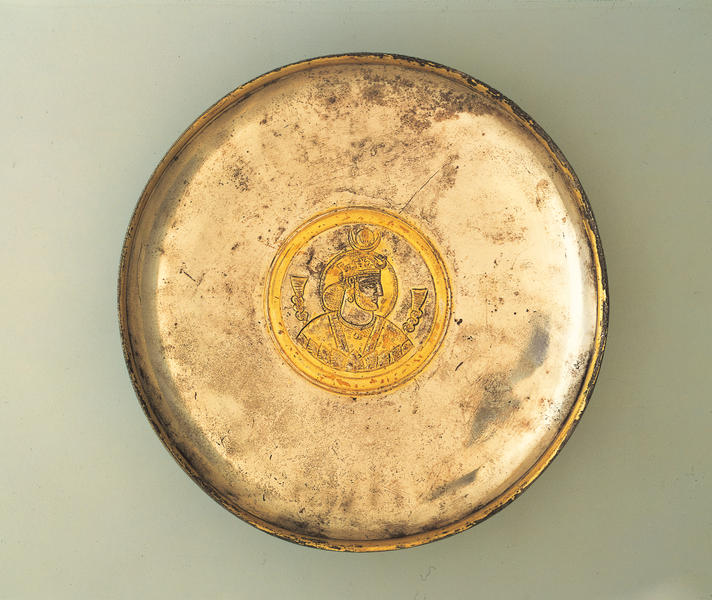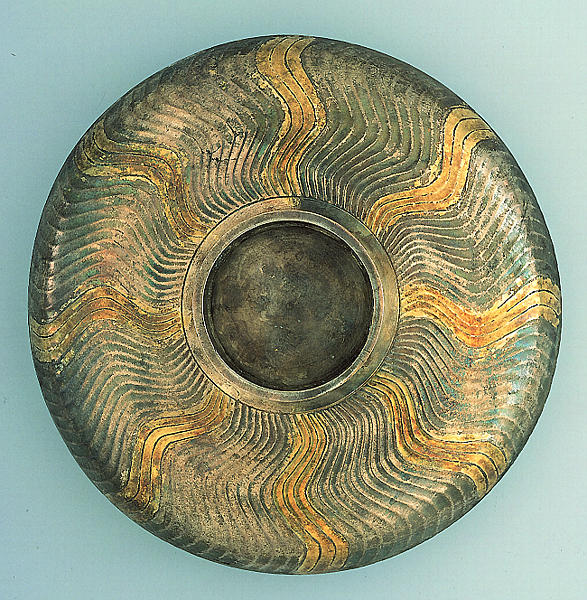Plate with the Bust of a King
- Allegedly Iran
- Persia, Sasanian period
- 6th century
- Silver gilt
- H-4.1 D-22
Catalogue Entry
Enclosed within a circular frame on the inner surface of this finely worked vessel is the bust of a Sasanian king wearing a crown similar to those that appear on Sasanian coins minted by several kings between the mid-fifth and the mid-seventh century A.D.1 In this respect the plate is unique, as all other Sasanian silver vessels decorated with medallion "portraits" of the king, princes, high officials, and female members of the royal family are products of a much earlier period--the third and the early fourth centuries A.D.2 After the late fourth century, the king invariably is represented on Sasanian silver vessels in hunting or enthronement scenes and not as a bust within a circular frame.
On the exterior of this silver-gilt vessel, undulating fluted lines extend from the foot ring to a point just below the rim. Early Sasanian bowls with medallion "portraits" also have fluted decoration but the fluting is found on the interior surface and is in the form of straight lines extending horizontally or in a radial fashion from the central medallion. Although the rippled fluted exterior surface of the present plate is not a standard Sasanian feature, this type of decoration is not uncommon on late antique (third century A.D.) vessels excavated west of Iran in Georgia (Transcaucasus). Finds made in Georgia also include Roman silver plates of the second century A.D. decorated with medallion portraits--works of art that served as prototypes for the official imagery on slightly later Sasanian vessels.3 Two of the earliest, third-century Sasanian silver vessels decorated with medallion "portraits" of a Sasanian king and local authority were found in Georgia: One is a cup from Zargveshi (western Georgia) and the other is a plate excavated at Mtskheta (eastern Georgia-Iberia).4
From the end of the fourth to the early sixth century, Georgia was a divided land. The west was under the influence of Byzantium and the eastern region (Iberia), while politically unstable, was under the control of an Iranian Georgian monarchy. The art and coinage of the Caucasus region in the first half of the first millennium A.D. reflect these foreign presences. Certain local princes of eastern Georgia who became independent in the late sixth and the seventh centuries issued coins derived from the coin type of one of the late Sasanian kings, Hormizd IV (r. A.D. 586-87), who is shown on Sasanian coins wearing a crown identical to that on this silver-gilt plate.5
The style and all details of the royal image on the Shumei plate are in accordance with a sixth-century work of Sasanian manufacture. While the source of the vessel is alleged to be Iran, it must be acknowledged that the profile--flat, with a sharply upturned rim--the use of the medallion "portrait" at this late date, and the undulating fluted decoration of the exterior are all anomalies in the corpus of Sasanian silver plates. Since the original provenance and subsequent history of this vessel remain uncertain, it is impossible to determine whether the place of manufacture was in the eastern Caucasus, at a time in the early sixth century when that area came under direct Sasanian control, or in Iran. Details of the royal dress, the crown type, the double-beaded crown diadem, and the ribbons that flutter from either side of the frontal bust on the silver plate also characterize the coin images of Khosro I (r. A.D. 531-79), a Sasanian king who ruled in the period in which Georgia was incorporated into the Sasanian realm and the authority of the Georgian royal house came to an end. Considered in this historical context, the reappearance of the royal medallion "portrait"--an ancient and familiar motif associated with third- and fourth-century Sasanian authorities in Georgia--on this sixth-century Sasanian silver plate is not surprising. In addition to illustrating the influence of contemporary events on the art of the late Sasanian period and the mixed cultural heritage of the era, this Shumei silver-gilt vessel is an exceptionally fine work of art.
POH
1. See Gl 1971, Table XIV.
2. See Harper and Meyers 1981, pp. 24-39, pls. 1-7.
3. See Machabeli 1983, pls. 26, 36, 37, 40, 41 (undulating lines); pls. 21, 47, 48 (Roman medallion portraits).
4. See Harper and Meyers 1981, pls. 2 and 1, respectively.
5. See Lang 1957, pp. 139-40.

